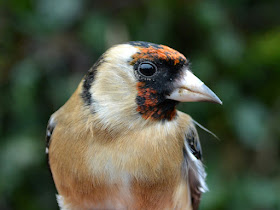Anyway back to the bird in question and it is important to say that it is a first year bird, based on the shape of the tail feathers, and possibly a male as there was a slight pinkish wash on a few of the feathers of the rump. Now I am not going to rhyme off all the reasons why I think it could be a Coues's, or perhaps I should say Coues's type now that research has shown there is essentially no genetic difference between Lesser, Common and Coues's, but relevant comments accompany some of the images.
 |
| The sharply pointed tail feathers made it easy to age as a first year bird. |
 |
| The rump is one of the critical features and while the unstreaked area is not as extensive as on some Coues's it still falls within the range of streaking that can be displayed. |
 |
| A slight change of angle and lighting and the head looks even paler. The limited flank streaking is set against a pure white ground colour. |
 |
| That puffed-up look again. While there is some streaking in the rump the ground colour of the rump and lower back is pure white. |
 |
| The bill was fairly stubby and conical. The eye also looked relatively small which is also a feature of Coues's. |
So what is it? Well it is...... ummm, one of them isn't it - not easy and not straightforward. There simply isn't a clear cut divide in appearance between Common and Coues's so a bird like this will always be controversial to some degree but that doesn't mean it should be called a Mealy because it is the 'safer' option. As the late Martin Garner put it 'Calling a bird a Mealy Redpoll when it is really an 'intermediate'/possible Coues's should be a bookable offence!' Some of his later writings suggested he had become much more confident about identifying streaky Coues's and again as Martin put it 'Most Arctic Redpolls are streaky. Really. They are. Which is annoying as they are supposed to be nice and plain and white in redpoll folk lore. It's often subtly different kind of streaking, but they are often streaky, even some adult males. Streaky is OK.'
So what a way to end my ringing in 2016. This was the last bird caught in the last ringing session and literally came in the last minute of extra time..... and it certainly is one of them, isn't it?
There is tons of stuff on the web about the identification of Coues's Arctic (Hoary) and Common (Mealy) Redpolls and some I found useful can be found by clicking on the following links:
Identification of Arctic Redpolls carduelis hornemanni exilipes, British Birds
Arctic Redpoll Carduelis hornemanni exilipes an identification review based on the 1995/96 influx, British Birds
Intermediate Arctic Redpoll, Birding Frontiers
Arctic Redpoll and Mealy Redpoll, Change the ID Culture, Birding Frontiers
Urging caution when identifying Common Redpolls, Sibley Guides Notebook

























































